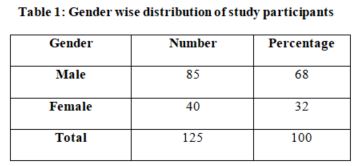Infiltration of Appendix with Eosinophils in Acute Appendicitis: A Prospective Study
Abstract
Background and Aim: Acute eosinophilic appendicitis is an uncommon ammatory condition of appendix. The histological hallmark of the entity is eosinophilic in rather than neutrophilic, of the muscularis propria with accompanying edema, separating muscle. The aim of the present study was to study the etiology and prevalence of eosinophilic appendicitis.
Material and Methods: The tissue specimens were included from the appendectomy procedure done either as elective or emergency procedure in the surgical department of the hospital. Total of 125 cases where studied for the period of one year. The related clinical history and the data of the patients were obtained from the surgical department of the hospital. The tissue samples of the studied cases were processed in the department of pathology. For light microscopy one slide from each block was stained with H&E to arrive at a diagnosis.
Results: In 125 cases of appendectomies were studied out of which 73 cases (59%) of the appendectomies were performed as an emergency procedure and 52 cases (41%) were done as an elective procedure. Out of 125 cases, 118 cases (95%) of the appendectomy specimens showed congested and dilated blood vessels on the external surface, 121 cases (97%) of appendectomy were send along with mesoappendix which also showed signs of congestion. The major cause of appendectomies performed was for acute appendicitis 72 cases (58%) followed by periappendicitis 17 cases (13.2%).In the cases of acute appendicitis and periappendicitis, also a male predominance was seen, which was 72 cases(57.6%) and 9 cases (55%).
Conclusion: The etiology of appendicitis is multifactorial: obstruction, diet and infection. Inflammation triggered by type 1 hypersensitivity allergic response is a recently described etiology. Acute eosinophilic appendicitis shares similar morphological features as acute appendicitis with a male predominance. It is most commonly seen between the age group of 20-30 years of age. Histopathologic features of acute eosinophilic appendicitis include absence of neutrophils,
Downloads
References
[2] Hardin Jr DM: Acute appendicitis: review and update. American family physician 1999, 60:2027.
[3] Abdalla AKM: The Implication of Malaria as a Possible Aetiological Factor in Acute Appendicitis in Wad Medani, Gezira State, Sudan (2016). University of Gezira, 2017.
[4] Pai RK, Longacre TA: Appendiceal mucinous tumors and pseudomyxoma peritonei: histologic features, diagnostic problems, and proposed classification. Advances in anatomic pathology 2005, 12:291-311.
[5] Smith HF, Parker W, Kotzé SH, Laurin M: Multiple independent appearances of the cecal appendix in mammalian evolution and an investigation of related ecological and anatomical factors. Comptes Rendus Palevol 2013, 12:339-54.
[6] Al-Mulhim A: Acute appendicitis in pregnancy. A review of 52 cases. International surgery 1996, 81:295-7.
[7] Jona JZ, Belin RP, Burke JA: Eosinophilic infiltration of the gastrointestinal tract in children. American Journal of Diseases of Children 1976, 130:1136-9.
[8] Aravindan K, Vijayaraghavan D, Manipadam MT: Acute eosinophilic appendicitis and the significance of eosinophil-Edema lesion. Indian Journal of Pathology and Microbiology 2010, 53:258.
[9] MacLeod C: Some Observations on Acute Appendicitis. Postgraduate medical journal 1937, 13:170.
[10] Simon GL, Hotez PJ, Tsuji M: Abhay R. Satoskar, MD, PhD.

Copyright (c) 2021 Author (s). Published by Siddharth Health Research and Social Welfare Society

This work is licensed under a Creative Commons Attribution 4.0 International License.


 OAI - Open Archives Initiative
OAI - Open Archives Initiative


